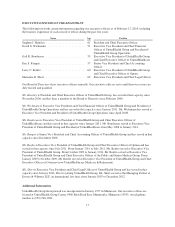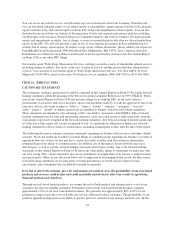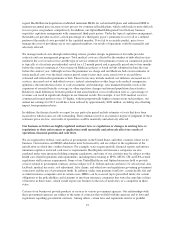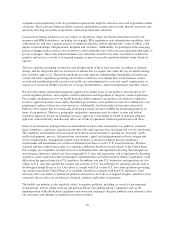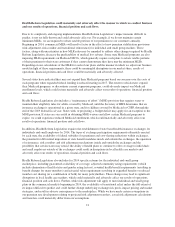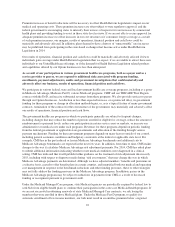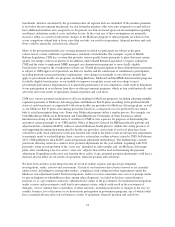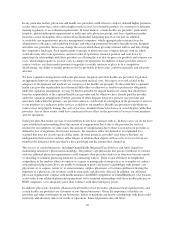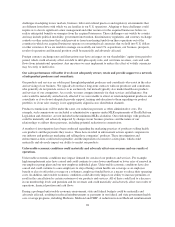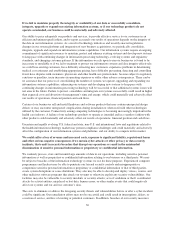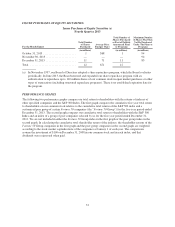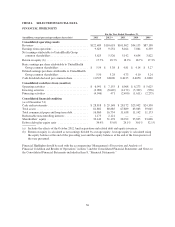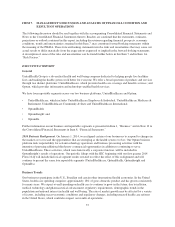United Healthcare 2013 Annual Report Download - page 29
Download and view the complete annual report
Please find page 29 of the 2013 United Healthcare annual report below. You can navigate through the pages in the report by either clicking on the pages listed below, or by using the keyword search tool below to find specific information within the annual report.Because of the nature of our business, we are routinely subject to various litigation actions, which could
damage our reputation and, if resolved unfavorably, could result in substantial penalties and/or monetary
damages and materially and adversely affect our results of operations, financial position and cash flows.
Because of the nature of our business, we are routinely made party to a variety of legal actions related to, among
other matters, the design, management and delivery of our product and service offerings. These matters have
included or could in the future include claims related to health care benefits coverage and payment (including
disputes with enrollees, customers, and contracted and non-contracted physicians, hospitals and other health care
professionals), tort (including claims related to the delivery of health care services, such as medical malpractice
by health care practitioners who are employed by us, have contractual relationships with us, or serve as providers
to our managed care networks), contract and labor disputes, tax claims and claims related to disclosure of certain
business practices. We are also party to certain class action lawsuits brought by health care professional groups
and consumers. In addition, we periodically acquire businesses or commence operations in jurisdictions outside
of the United States, where contractual rights, tax positions and applicable regulations may be subject to
interpretation or uncertainty to a greater degree than in the United States, and therefore subject to dispute by
customers, government authorities or others. We are largely self-insured with regard to litigation risks. Although
we maintain excess liability insurance with outside insurance carriers for claims in excess of our self-insurance,
certain types of damages, such as punitive damages in some circumstances, are not covered by insurance.
Although we record liabilities for our estimates of the probable costs resulting from self-insured matters, it is
possible that the level of actual losses will significantly exceed the liabilities recorded.
We cannot predict the outcome of significant legal actions in which we are involved and are incurring expenses
in resolving these matters. The legal actions we face or may face in the future could further increase our cost of
doing business and materially and adversely affect our results of operations, financial position and cash flows. In
addition, certain legal actions could result in adverse publicity, which could damage our reputation and
materially and adversely affect our ability to retain our current business or grow our market share in select
markets and businesses.
Any failure by us to manage successfully our strategic alliances or complete, manage or integrate
acquisitions and other significant strategic transactions or relationships could materially and adversely
affect our business, prospects, results of operations, financial position and cash flows.
As part of our business strategy, we frequently engage in discussions with third parties regarding possible
investments, acquisitions, divestitures, strategic alliances, joint ventures, and outsourcing transactions and often
enter into agreements relating to such transactions. For example, we have a strategic alliance with AARP under
which we provide AARP-branded Medicare Supplement insurance to AARP members and other AARP-branded
products and services to Medicare beneficiaries. If we fail to meet the needs of our alliance or joint venture
partners, including by developing additional products and services, providing high levels of service, pricing our
products and services competitively or responding effectively to applicable federal and state regulatory changes,
our alliances and joint ventures could be damaged or terminated, which in turn could adversely impact our
reputation, business and results of operations. Further, if we fail to identify and complete successfully
transactions that further our strategic objectives, we may be required to expend resources to develop products and
technology internally, we may be placed at a competitive disadvantage or we may be adversely affected by
negative market perceptions, any of which may have a material adverse effect on our results of operations,
financial position or cash flows. For acquisitions, success is also dependent upon efficiently integrating the
acquired business into our existing operations, including our internal control environment, which may present
challenges that are different from those presented by organic growth and that may be difficult for us to manage.
If we are unable to successfully integrate and grow these acquisitions and to realize contemplated revenue
synergies and cost savings, our business, prospects, results of operations, financial position and cash flows could
be materially and adversely affected.
As we continue to expand our business outside the United States, acquired non-U.S. businesses, such as Amil,
will present challenges that are different from those presented by acquisitions of domestic businesses, including
27


